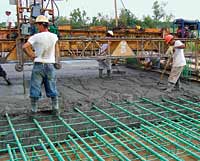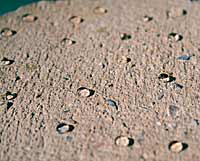Products Made of
Tackling other environmental problems
Despite the fact that few product loops are truly closed to date, working with MBDC and its cradle-to-cradle protocol creates a huge ripple effect both within and outside of a given company. "One of the interesting things about the MBDC protocol," says Berman, "is that it encourages you to go beyond the material itself to look at other opportunities." As a small but concrete illustration, he explains that MechoShade's fabric is trucked from the mill on rolls of long cardboard tubes. For years, the company had been paying to cut and landfill the leftover tubes that remained after the fabric was used up. After adopting cradle-to-cradle thinking, they now send the tubes back to the mill for reuse, saving both on the cost of new tubes and the landfill tipping charges.
Bonnema of Haworth reports that the MBDC's certification process made the company think about alternative energy sources and water quality. The plant that assembles its Zody chair runs off wind power. And although Haworth had no significant problems with its effluent, the manufacturer chose to eliminate phosphate from its processing line to even better protect its regional watershed.
|
|||||
Big furniture-systems companies such as Haworth and Steelcase are parlaying the knowledge gained through working with MBDC in the development of specific products to their management of all product design. For example, after learning about the production of PVC-"wow, that's a nasty process," exclaims Smith-Steelcase's product development team came to the decision that, despite the fact that PVC is an inexpensive and well-performing ingredient, the company wants to eliminate it from its products by 2012 so as not to continue contributing to the demand for the problematic substance. And Smith explains that, by letting suppliers know its interests and concerns, Steelcase recently identified an affordable formaldehyde-free component on the market that they now plan to substitute for one containing formaldehyde on the interior section of their panel system.
Having learned from MBDC, these enlightened manufacturers are looking at ways to educate and transform their own broader circles. As a small indication of the gradual progress being made among Haworth's suppliers, Bonnema notes that the Furniture Emissions Standard Subcommittee of Business and Institutional Furniture Manufacturer's Association (BIFMA), on which he serves, just released a draft of standard and test methods for measuring emissions from office furniture for public comment. One of the goals in this endeavor is to provide an alternative method for the testing of low-emitting products for the commercial interiors version of the U.S. Green Building Council's LEED rating system. And Smith participates in the local chapter of the Green Supplier's Network, which is sponsored nationwide by the U.S Environmental Protection Agency.
"The reaction from suppliers has been amazingly positive," reports Smith. He is referring to not only those manufacturers, which he calls "tier one," that supply components to the furniture companies, but even to the suppliers of the suppliers of the suppliers. "We have a global supply chain. The tier four are typically big companies like BASF, which is also working with MBDC. We have the same protocols in place so we can all look at them together in anticipation of our customers' needs." And, going out yet another rung, Smith just joined the Board of Councilors for the China-U.S. Center for Sustainable Development whose founding cochairs are William McDonough and Madame Deng Nan, vice minister of China's Ministry of Science and Technology. A small ripple in Charlottesville seems to be making waves across the globe.










